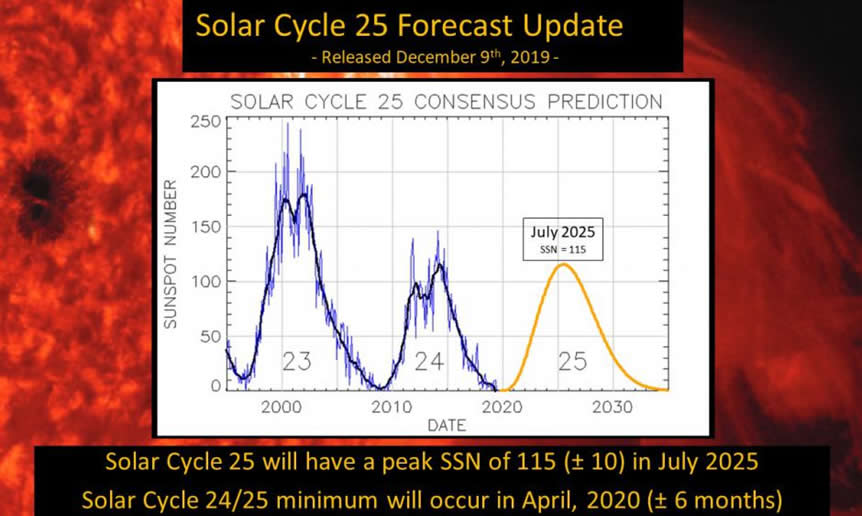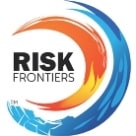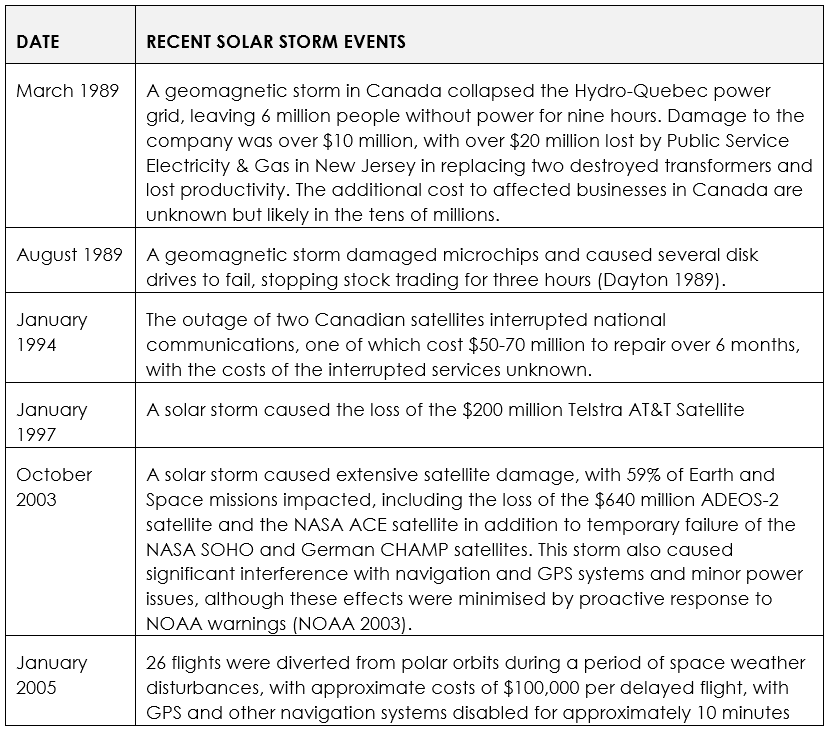The 25th Solar Cycle is about to begin, with new evidence for enormous solar storms
Solar Cycle 25 is the upcoming and 25th solar cycle since 1755, when extensive recording of solar sunspot activity began. It is expected to begin around April this year and continue past 2030 (see Figure 1). Stronger solar activity tends to occur during odd-numbered solar cycles with a number of events occurring during cycle 23 (see table at the end of this briefing), however solar events are more frequent near any maxima such as the Quebec geomagnetic storm in 1989 which coincided with cycle 22.

Even moderate space weather events cause significant risks to airline communications and power industries through service interruptions as well as potential damage. Severe incidents are capable of damaging or destroying the very large high-voltage transformers on which our power networks depend with replacements for these custom-built components potentially taking years to implement. Internationally, such damage is often covered by traditional insurance policies through the prolonged effect of power outages. In Australia insurers are likely to be less impacted, however the impact on business would be severe; businesses would need to have negotiated the inclusion of public utilities extension in policies for failure of electricity supply and utility companies are not liable for failure to supply electricity in the event of a natural disaster.
The most severe event in recorded history was the Carrington event of 1859, where auroral effects were clearly visible at mid-latitudes across the globe, for example in Sydney. It is estimated this event was at least twice as severe as the 1989 Quebec event. Extreme events such as these are a concern for re-insurers because their global scale limits the effectiveness of regional diversification.
Of particular note is the risk to satellites, with approximately two thirds of the 35 satellites launched annually covered by damage and liability insurance, up to a value of $700 million (Lloyds 2010). Between 1996 and 2005, insurers paid nearly US$2 billion to cover satellite damage, of which a significant proportion is solar-related and it is estimated that solar disruptions to satellites cost on the order of $100 million a year (Odenwald and Green, 2008).
The flow-on impacts of power cuts to other industries can be significant, with studies suggesting brownouts and blackouts in the USA causing $80 billion of economic losses every year (Odenwald & Green 2008). Between June 2000 and December 2001, it is estimated that solar storms increased the total cost of electricity in the US by $500 million. The capacity of even moderate events to cause significant cost is exemplified in the solar incidents, listed in the table at the end of this briefing, that occurred during recent solar maxima.
With the onset of the next odd-numbered solar maximum this year, an increased frequency of solar event activity as the cycle progresses is expected, especially in the moderate to severe intensity range. Moderate events have been easily dealt with by insurance companies and are unlikely to affect large portions of the planet. Solar storm impacts are most significant in areas close to the poles, with a reduced likelihood of widespread power failure in Australia. The risk is, however, non-zero with the drive to inter-connect our power networks through long transmission lines increasing the susceptibility to Geomagnetic Induced Currents (GICs). Although space-weather alerts issued by the Bureau of Meteorology are monitored to mitigate the risk by compartmentalizing the network during event occurrence, the residual risk has not been studied. The implications for emergency management, for example, of widespread power outage and the cascading effects of our increasingly interconnected networks are similarly unstudied in an Australian context, particularly if a system is already under stress, say, during a heatwave.
In addition to the consideration of purely local effects, the impacts of solar storms on communication and navigation systems world-wide and in space are likely to have flow-on effects for productivity to Australian businesses.
Although the incidence of moderate solar effects is expected to increase, extreme events at the Carrington scale are not well correlated with the solar cycle. A recent discovery of evidence in Greenland for a huge solar storm that occurred 2,500 years ago is thought to be of similar magnitude to an event in 774–775AD where there was an observed increase of 1.2% in the concentration of carbon-14 isotope in tree rings in Japan dated to the years 774 or 775 AD (Miyake et al., 2012). A surge in beryllium isotope 10Be, detected in Antarctic ice cores, has also been associated with this event, suggesting that it was a solar flare having global impact. Although a solar flare event will not have the geomagnetic effects on our power network that an event such as the Carrington or 1989 Quebec events would, the implications for our satellite systems – imaging, GPS, communications, and so on – would be catastrophic. The new discovery gives some frequency context to this, suggesting a return period on the order of 1000 years, which, although large, should not be ignored given the likely severity of such an event. An event at ARI 1000 would have a 3% chance to occur once in a 30-year period.
The following article, by Ian Sample, Science Editor of The Guardian, appeared on 12 March 2019 under the title “Radioactive particles from huge solar storm found in Greenland.”
Traces of an enormous solar storm that battered the atmosphere and showered Earth in radioactive particles more than 2,500 years ago have been discovered under the Greenland ice sheet. Scientists studying ice nearly half a kilometre beneath the surface found a band of radioactive elements unleashed by a storm that struck the planet in 660BC. It was at least 10 times more powerful than any recorded by instruments set up to detect such events in the past 70 years, and as strong as the most intense known solar storm, which hit Earth in AD775.
Raimund Muscheler, a professor of quaternary sciences at Lund University in Sweden, said: “What our research shows is that the observational record over the past 70 years does not give us a complete picture of what the sun can do.” The discovery means that the worst-case scenarios used in risk planning for serious space weather events underestimate how powerful solar storms can be, he said.
Solar storms are whipped up by intense magnetic fields on the surface of the sun. When they are pointed toward Earth they can send highly energetic streams of protons crashing into the atmosphere. The sudden rush of particles can pose a radiation risk to astronauts and airline passengers, and can damage satellites, power grids and other electrical devices.
Scientists have come to realise over the past decade that intense solar storms can leave distinct traces when they crash into the planet. When high energy particles slam into the stratosphere, they collide with atomic nuclei to create radioactive isotopes of elements such as carbon, beryllium and chlorine. These can linger in the atmosphere for a year or two, but when they reach the ground they can show up in tree rings and ice cores used to study the ancient climate.
Muscheler’s team analysed two ice cores drilled from the Greenland ice sheet and found that both contained spikes in isotopes of beryllium and chlorine that date back to about 660BC. The material appears to be the radioactive remnants of a solar storm that battered the atmosphere.
The scientists calculate that the storm sent at least 10bn protons per square centimetre into the atmosphere. “A solar proton event of such magnitude occurring in modern times could result in severe disruption of satellite-based technologies, high frequency radio communication and space-based navigation systems,” they write in Proceedings of the National Academy of Sciences.
Britain’s emergency plans for severe space weather are based on a worst-case scenario that involves a repeat of the 1859 Carrington event. This was a powerful geomagnetic storm set off by a huge eruption on the sun known as a coronal mass ejection. A 2015 Cabinet Office report anticipated only 12 hours warning of a similar storm that could lead to power outages and other disruption. The discovery of more powerful solar storms in the past 3,000 years suggests that space weather can be worse than the UK plans for. “The Carrington event is often used as a worst-case scenario, but our research shows that this probably under-estimates the risks,” said Muscheler.
REFERENCES
Brooks, M. (2009) Space storm alert: 90 seconds from catastrophe. New Scientist 2700
Burns, A.G., Killeen, T.L., Deng, W., Cairgnan, G.R., and Roble, R.G. (1995)
Dayton (1989) Solar storms halt stock market as computers crash. New Scientist 1681
Lloyd’s (2010) Insurance on the Final Frontier. Available from http://www.lloyds.com/News-and-Insight/News-and-Features/Specialist/Specialist-2010/Insurance_on_the_final_frontier
Marshall et al, A preliminary risk assessment of the Australian region power network to space weather, SPACE WEATHER, VOL. 9, S10004, doi:10.1029/2011SW000685, 2011
Miyake, F., K. Nagaya, K. Masuda, and T. Nakamura (2012). A signature of cosmic-ray increase in AD 774-775 from tree rings in Japan. Nature, Volume 486, Issue 7402, pp. 240-242 (2012).
NASA (2008) A Super Solar Flare. Available from http://science.nasa.gov/science-news/science-at-nasa/2008/06may_carringtonflare/
NOAA (2003) October-November 2003 Solar Storm. Available from http://www.magazine.noaa.gov/stories/mag131b.htm
Odenwald, S.F. and Green, J.L. (2008) Bracing the Satellite Infrastructure for a Solar Superstorm. Scientific American, available from http://www.scientificamerican.com/article.cfm?id=bracing-for-a-solar-superstorm
Sample, Ian (2019). Radioactive particles from huge solar storm found in Greenland. https://www.theguardian.com/science/2019/mar/11/radioactive-particles-from-huge-solar-storm-found-in-greenland
Solar Storms (unknown date) Available from http://www.solarstorms.org/SRefStorms.html
About the author/s

Paul Somerville
Paul is Chief Geoscientist at Risk Frontiers. He has a PhD in Geophysics, and has 45 years experience as an engineering seismologist, including 15 years with Risk Frontiers. He has had first hand experience of damaging earthquakes in California, Japan, Taiwan and New Zealand. He works on the development of QuakeAUS and QuakeNZ.

